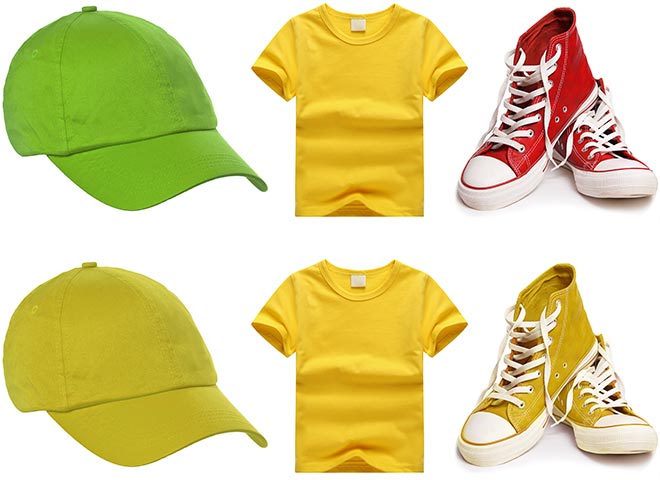 Color blindness means that the light-sensitive cells in the retina are not responding appropriately to variations in wavelengths of light that enable people to see an array of colors. The picture above gives you an idea of what that might be like.
Color blindness means that the light-sensitive cells in the retina are not responding appropriately to variations in wavelengths of light that enable people to see an array of colors. The picture above gives you an idea of what that might be like.
It can manifest to varying degrees and so it can be modest or quite profound. People who have this generally adapt quite easily without too much trouble, but as a note of caution, if you are profoundly red-green colour blind then please, for your own safety, don’t consider a career as an electrical engineer.
EnChroma glasses have been commercialised as a solution. They specifically claim that these glasses …
bring vibrant color to adults and kids with STRONG PROTAN color blindness
They are very expensive, but if they actually work, then it would potentially be a life changing pair of glasses.
Do they work?
A study has been published in Optics Express in which Scientists from the University of Granada ran some tests to find out.
Do EnChroma glasses improve color vision for colorblind subjects?
What was the study focused on finding out?
They were asking the rather obvious question – Do EnChroma glasses enable colour blind people to be able to see new colours or even correct colour vision deficiency (CVD)?
What did they do?
We evaluate the effectiveness of these glasses using two complementary strategies for the first time.
The first consists of using the three classical types of tests — recognition, arrangement and discrimination — with and without glasses, with a high number of individuals.
In the second, we use the spectral transmittance of the glasses to simulate the appearance of stimuli in a set of scenes for normal observers and observers with CVD.
What did they discover?
As you can probably guess, the magic glasses did not deliver on the promises …
The results show that the glasses introduce a variation of the perceived color, but neither improve results in the diagnosis tests nor allow the observers with CVD to have a more normal color vision.
How could they possibly work?
The answer is that they can’t.
Luis Gómez Robledo, professor from the UGR Department of Optics and one of the authors of this paper, explains it all in a bit more detail …
“normal human color vision is trichromatic thanks to a cluster of three types of photoreceptors known as cones, which are present in the retina. These cones are sensitive to short wavelengths (S), medium wavelengths (M) and long wavelengths (L). However in Europe, about 8% of men and 0.5% of women in the Caucasian population suffer from some type of congenital anomaly in the performance of some of the cones, which causes color vision deficiencies. This anomaly is a sex‑linked recessive trait, with the red‑green color vision deficiency being the most frequent in humans.” Said red‑green CVD is in turn classified into two types: protan and deutan, depending on the affected cones. Moreover, there is another classification based on the severity of the deficiency: protanomalous or deuteranomalous, and protanopic or deuteranopic.
A pair of glasses are not going to repair your cones so how could they possibly work?
What EnChroma claim is that the glasses block specific wavelengths of light, and by doing so the contrast of what is left will help you to distinguish different colours more easily.
The study finds that a color blind person using the EnChroma® glasses will not perceive new colors, but rather they will see the same colours in a different way.
“This makes possible for some individuals using these glasses to distinguish some colors, but to the detriment of others which will be now confused. Even though a color filter as that used by the EnChroma®glasses may change the appearance of colors, it will never make color vision more similar to a normal observer’s vision,” the authors state.
This is not a new concept.
You can buy a far cheaper pair of hunting glasses to get the same effect. Coloured hunting glasses work by helping you to better perceive certain stimuli thanks to an increased contrast with the surroundings.
Claims being watered down
One claim on the company’s website (at least until October 2017) was that their glasses …
“are designed to improve the everyday experience of color vision”.
However, that claim has been recently substituted by a more subtle sentence:
“the glasses are an optical assistive device for enhancement of color discrimination in persons with color blindness; they are not a cure for color blindness”,
… pointing out that …
“results vary depending on the type and extent of color vision deficiency per individual.”
There has been a lot of marketing hype regarding these glasses, especially when they first hit the market, but much of that is now gone, and rightly so. As revealed by this study, they do not improve colour vision for colour blind people nor do they correct their colour blindness. They are simply a very expensive pair of hunting glasses.
One Last Observation
The lead author, Luis Gómez Robledo, who carries out his research in the field of colour vision, is highly motivated to find something that does work. He would have loved to discover that these glasses work because he himself is colour blind. Unfortunately they don’t.

They should work with protanomaly and deutanomaly, but not protanopia or deutanopia.